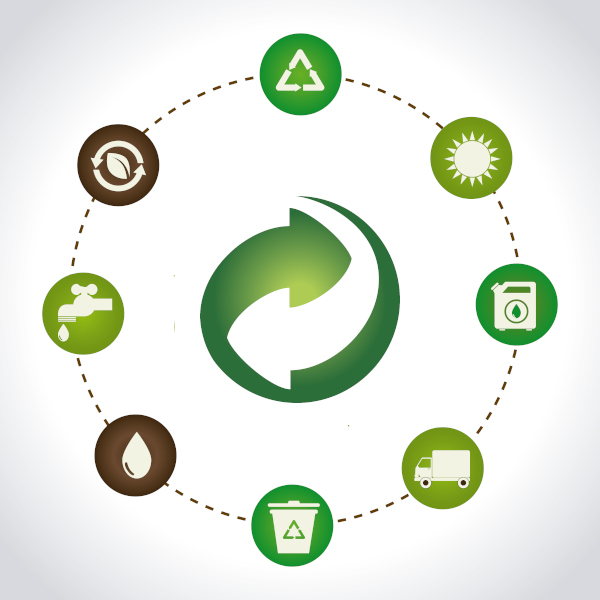
Every production process and every service has an effect on the natural environment: energy, resources and water are consumed, CO2 and other gaseous and solid waste is created as unwanted byproducts. In strict conformity with DIN-EN-ISO standards, every year the Green Dot draws up an Environmental Performance Balance, confirmed by expert appraisers, for an ecological assessment of its work. The results of the analyses it contains are used to make decisions concerning ecological optimization of processes on a sound evidentiary basis. The Environmental Performance Balance for 2022 has been prepared by ifeu Heidelberg.
For the Environmental Performance Balance, Der Grüne Punkt determines the consumption of energy and resources, and the quantity of emissions produced during the individual processes of the recycling operation. Sorting lines consume electricity, trucks are powered by diesel fuel, and generate exhaust gases while transporting the recyclables. On the other hand, the glassworks save large amounts of energy when they utilize glass cullet for their production process instead of primary raw materials, and the use of plastic regranulates made from used packaging in an injection-molding production process reduces the consumption of crude oil, which is required for making new plastic granulates.
All the individual quantities itemized in the balance are ecologically assessed and grouped together in impact categories. Energy and resource consumption, plus the emissions from the recycling process, are compared to the relevant impact categories for primary production. The Environmental Performance Balance contrasts the effects of the two systems - while of course postulating the same product benefits for both primary production and recycling. Only when the manufacture of a product as the result of a recycling process leads to savings in comparison to primary production will recycling make ecological sense.
But the Environmental Performance Balance provides even more: each process step can be precisely analyzed and assessed, thus revealing potential for optimizing the recycling operation and computing the efficacy of alternatives. This means the Environmental Performance Balance constitutes the basis for further improvements in package recycling – in both economic and ecological terms.
Energy consumption
Does recycling save primary energy, and if so, how much? This is stated in megajoules (MJ). In 2022 19 billion MJ have been saved.
Greenhouse effect
How does recycling affect the emissions of climatolo-gically harmful gases? Besides carbon dioxide (CO2), these may also be other gases, like methane (CH4) or laughing gas (N2O), which make differently impactful contributions towards global warming. The effect is accordingly stated in CO2 equivalents (CO2eq.). In 2022 622,000 tonnes of CO2eq. have been avoided.
Acidification
Many substances, such as the degradation products of biological waste, contribute towards causing the pH value in the soil to fall, and in the seas as well. The Environmental Performance Balance calculates in terms of sulfur dioxide equivalents (SO2eq.) what quantities of these substances are being avoided by recycling. The number for 2022: 2.4 million kilograms of SO2eq.
Eutrophication
Effluents from industrial facilities and farms carry fertilizing substances into bodies of water and may lead to excessive growth of plants and animals. The resultant shortage of oxygen endangers the ecosystems of the bodies of water concerned. Here, too, recycling helps to reduce emissions – the Environmental Performance Balance contains a quantification in phosphate equivalents (PO4eq.): 1.5 million kilograms in 2022.